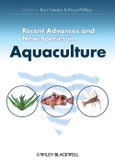Every aspect of the growing field has been addressed with coverage spanning recent technological development, new species, recent changes and global trends. More specifically, you will find information on the culture of species such as barramundi, cobia, dolphin fish, spiny lobsters, slipper lobsters, mud crabs, penaeid prawns, Nile tilapia, yellow king fish, abalone, sea cucumber and sea urchin, seaweed, ornamentals and Indian major carps, fugu, mud skippers, cephalopods and blue fin tuna.
The technological innovations and introduction of new species into aquaculture are critical to the evolution of the global aquaculture industry; an industry which is rapidly becoming one of the fastest growing in the world, having experienced huge advances across its many and diverse facets. Recent Advances and New Species in Aquaculture focuses explicitly on the ever-changing face of aquaculture, providing core scientific and commercially useful information on the remarkable growth in aquaculture production and in the advancement of new technological tools.
Written by many well respected international figures and drawn together and edited by Ravi Fotedar & Bruce Phillips, this exciting book is an essential purchase for anyone involved in or about to enter into the aquaculture industry.
Libraries in all universities and research establishments where aquaculture, fish biology, aquatic and environmental sciences and fisheries are studied and taught will find this an important addition to their shelves.
Recent Advances and New Species in Aquaculture is sure to become a key companion for all those studying aquaculture and a valuable source of reference for all personnel involved in the industry.
Table of Contents
Contributors.Abbreviations and acronyms.
Preface.
Acknowledgements.
1 Recent Developments (Ravi Fotedar, Gopal Krishna, Uras Tantulo, Iain Mcgregor and Bruce Phillips).
1.1 Introduction.
1.2 Disease resistance in aquaculture systems vis-à-vis breeding strategy.
1.3 Freshwater ornamental aquaculture – an industry view from Western Australia.
1.4 Use of immunostimulants as feed additives.
1.5 Alternative sites for aquaculture.
1.6 Future directions.
1.7 References.
2 A Global Review of Spiny Lobster Aquaculture (Bruce Phillips and Hirokazi Matsuda).
2.1 Introduction.
2.2 Broodstock management.
2.3 Larval rearing.
2.4 Raising wild-caught pueruli and juveniles.
2.5 Future developments.
2.6 References.
3 Slipper Lobsters (Manambrakat Vijayakumaran and Edakkepravan V. Radhakrishnan).
3.1 Introduction.
3.2 Biology.
3.3 Aquaculture potential.
3.4 Marketing.
3.5 Slipper lobster culture initiatives.
3.6 Hatchery production of seeds.
3.7 Factors influencing phyllosoma growth and survival.
3.8 Hatching and larval rearing in Thenus sp.
3.9 Growth of juvenile slipper lobsters.
3.10 Culture of Thenus sp.
3.11 Conclusions.
3.12 References.
4 Mud Crab Aquaculture (Brian D. Paterson and David L. Mann).
4.1 Introduction.
4.2 Portunid crab aquaculture.
4.3 Biology and life cycle.
4.4 Technology development.
4.5 Future developments.
4.6 References.
5 Penaeid Prawns (Ngo Van Hai, Ravi Fotedar and Nguyen Van Hao).
5.1 Introduction.
5.2 Achievements.
5.3 Challenges.
5.4 Prospective/future outlook.
5.5 References.
6 Cobia Culture (Ravi Fotedar and Huynh Minh Sang).
6.1 Introduction.
6.2 Morphology.
6.3 Distribution.
6.4 Biological characteristics.
6.5 Nutritional requirement of cobia.
6.6 Hatchery.
6.7 Growout.
6.8 Disease and health management.
6.9 Post-harvest and marketing.
6.10 Challenges and opportunities.
6.11 References.
7 Barramundi Aquaculture (Suresh Job).
7.1 Introduction.
7.2 Biology.
7.3 Hatchery production.
7.4 Hatchery culture.
7.5 Growout.
7.6 Nutrition and growth.
7.7 Health management.
7.8 Quality.
7.9 Sales and marketing.
7.10 Future directions.
7.11 Conclusions.
7.12 References.
8 Abalone Culture (Mark Allsopp, Fabiola Lafarga-De la Cruz, Roberto Flores-Aguilar and Ellie Watts).
8.1 Introduction .
8.2 The abalone market.
8.3 Abalone production technology.
8.4 Technological developments.
8.5 Future possibilities.
8.6 References.
9 Seaweed Culture with Special Reference to Latin America (Julieta Muñoz, Vivek Kumar and Ravi Fotedar).
9.1 Introduction.
9.2 Seaweed utilisation.
9.3 Aquaculture.
9.4 Integrated aquaculture.
9.5 Post-harvest: agar extraction.
9.6 Cultivation in Latin America.
9.7 Conclusions.
9.8 References.
10 Marine Ornamental Fish Culture (Suresh Job).
10.1 Introduction.
10.2 Broodstock and eggs.
10.3 Broodstock conditioning.
10.4 Larval culture.
10.5 Juveniles.
10.6 Commercial production.
10.7 Conclusions.
10.8 References.
11 Tilapia (Luan Dinh Tran, Trung Van Dinh, Thoa Phu Ngo and Ravi Fotedar).
11.1 Introduction.
11.2 Seed production.
11.3 Culture practices.
11.4 Harvesting and value added products.
11.5 Genetic improvement of tilapia.
11.6 Environment and disease management.
11.7 Marketing of tilapia.
11.8 Conclusion.
11.9 References.
12 Carp Polyculture in India (Dilip Kumar).
12.1 Introduction.
12.2 Freshwater aquaculture resources in India.
12.3 Development of aquaculture.
12.4 Commonly cultured species.
12.5 Aquaculture practices/systems.
12.6 Developments in culture practices.
12.7 Culture of pangasius (Pangasianodon hypophthalmus).
12.8 Freshwater prawn farming.
12.9 Recent developments.
12.10 References.
13 Future Directions (Bruce Phillips, Ravi Fotedar, Jane Fewtrell and Simon Longbottom).
13.1 Introduction.
13.2 Developments in managing the environmental impacts of aquaculture.
13.3 Ecolabelling.
13.4 The future.
13.5 References.
Index.
Colour plate.








